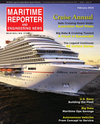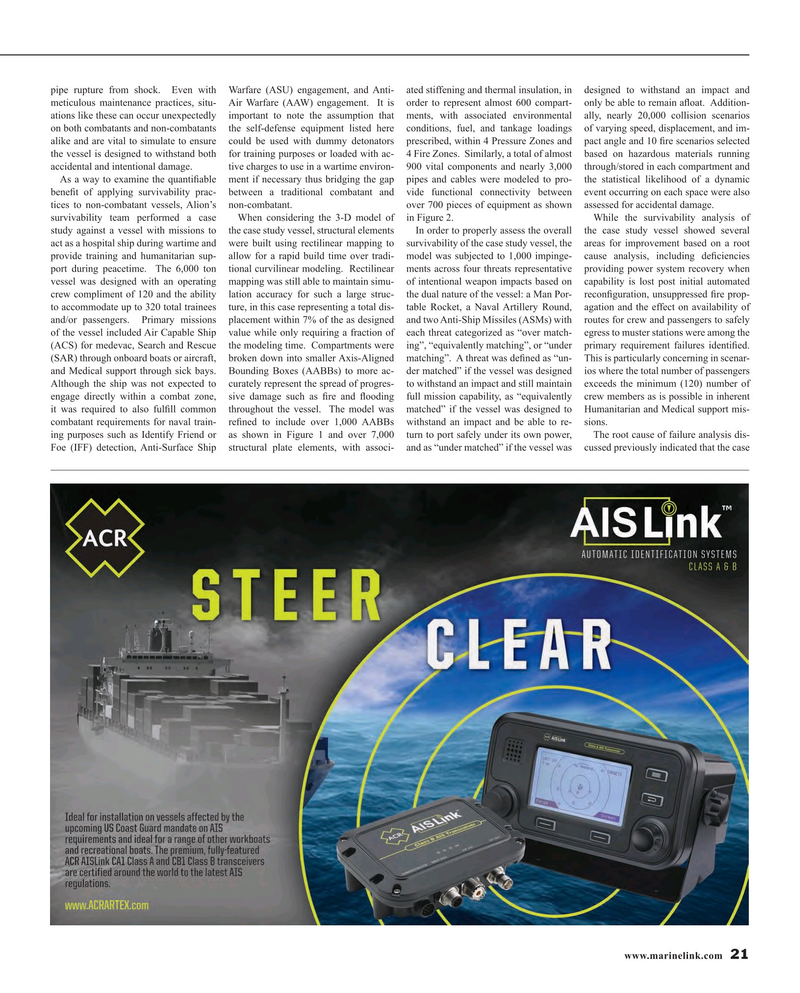
Page 21: of Maritime Reporter Magazine (February 2016)
Cruise Ship Technology Edition
Read this page in Pdf, Flash or Html5 edition of February 2016 Maritime Reporter Magazine
pipe rupture from shock. Even with Warfare (ASU) engagement, and Anti- ated stiffening and thermal insulation, in designed to withstand an impact and meticulous maintenance practices, situ- Air Warfare (AAW) engagement. It is order to represent almost 600 compart- only be able to remain a? oat. Addition- ations like these can occur unexpectedly important to note the assumption that ments, with associated environmental ally, nearly 20,000 collision scenarios on both combatants and non-combatants the self-defense equipment listed here conditions, fuel, and tankage loadings of varying speed, displacement, and im- alike and are vital to simulate to ensure could be used with dummy detonators prescribed, within 4 Pressure Zones and pact angle and 10 ? re scenarios selected the vessel is designed to withstand both for training purposes or loaded with ac- 4 Fire Zones. Similarly, a total of almost based on hazardous materials running accidental and intentional damage. tive charges to use in a wartime environ- 900 vital components and nearly 3,000 through/stored in each compartment and
As a way to examine the quanti? able ment if necessary thus bridging the gap pipes and cables were modeled to pro- the statistical likelihood of a dynamic bene? t of applying survivability prac- between a traditional combatant and vide functional connectivity between event occurring on each space were also tices to non-combatant vessels, Alion’s non-combatant. over 700 pieces of equipment as shown assessed for accidental damage.
survivability team performed a case When considering the 3-D model of in Figure 2. While the survivability analysis of study against a vessel with missions to the case study vessel, structural elements In order to properly assess the overall the case study vessel showed several act as a hospital ship during wartime and were built using rectilinear mapping to survivability of the case study vessel, the areas for improvement based on a root provide training and humanitarian sup- allow for a rapid build time over tradi- model was subjected to 1,000 impinge- cause analysis, including de? ciencies port during peacetime. The 6,000 ton tional curvilinear modeling. Rectilinear ments across four threats representative providing power system recovery when vessel was designed with an operating mapping was still able to maintain simu- of intentional weapon impacts based on capability is lost post initial automated crew compliment of 120 and the ability lation accuracy for such a large struc- the dual nature of the vessel: a Man Por- recon? guration, unsuppressed ? re prop- to accommodate up to 320 total trainees ture, in this case representing a total dis- table Rocket, a Naval Artillery Round, agation and the effect on availability of and/or passengers. Primary missions placement within 7% of the as designed and two Anti-Ship Missiles (ASMs) with routes for crew and passengers to safely of the vessel included Air Capable Ship value while only requiring a fraction of each threat categorized as “over match- egress to muster stations were among the (ACS) for medevac, Search and Rescue the modeling time. Compartments were ing”, “equivalently matching”, or “under primary requirement failures identi? ed. (SAR) through onboard boats or aircraft, broken down into smaller Axis-Aligned matching”. A threat was de? ned as “un- This is particularly concerning in scenar- and Medical support through sick bays. Bounding Boxes (AABBs) to more ac- der matched” if the vessel was designed ios where the total number of passengers
Although the ship was not expected to curately represent the spread of progres- to withstand an impact and still maintain exceeds the minimum (120) number of engage directly within a combat zone, sive damage such as ? re and ? ooding full mission capability, as “equivalently crew members as is possible in inherent it was required to also ful? ll common throughout the vessel. The model was matched” if the vessel was designed to Humanitarian and Medical support mis- combatant requirements for naval train- re? ned to include over 1,000 AABBs withstand an impact and be able to re- sions.
ing purposes such as Identify Friend or as shown in Figure 1 and over 7,000 turn to port safely under its own power, The root cause of failure analysis dis-
Foe (IFF) detection, Anti-Surface Ship structural plate elements, with associ- and as “under matched” if the vessel was cussed previously indicated that the case www.marinelink.com 21
MR #2 (18-25).indd 21 2/8/2016 3:29:03 PM

 20
20

 22
22
